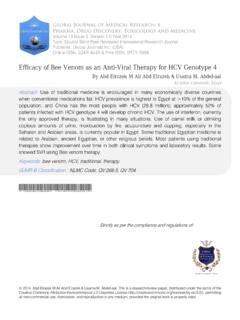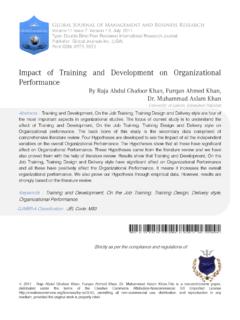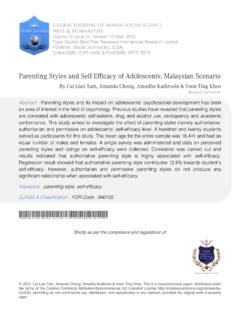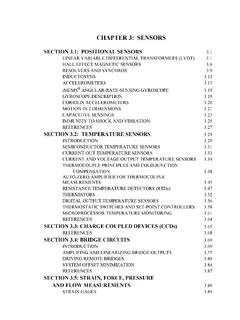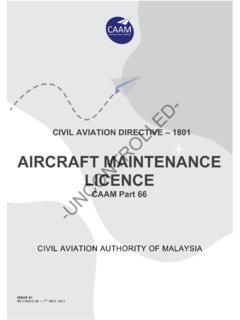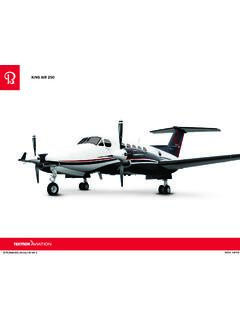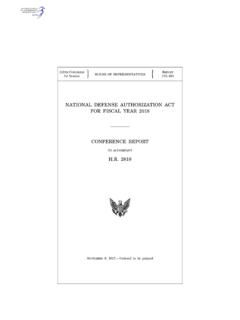Transcription of By Jahnavi & Avinash - Global Journals
1 2014. Jahnavi & Avinash . Th is is a research/review paper, distributed under the terms of the Creative Commons Attribution-Noncommercial Unported License http://creativecommons .org/licenses/by- ), permitting all non commercial use, distribution, and reproduction in any medium, provided the original work is properly cited. Global Journal of Researches in Engineering: B Automotive E ngineering Volume 14 Issue 4 Version Year 2014 Type: Double Blind Peer Reviewed International Research Journal Publisher: Global Journals Inc. (USA) Online ISSN: 2249-4596 & Print ISSN: 0975-5861 Aircraft Design and Weight Estimation Nomenclature By Jahnavi & Avinash Abstract- Weight components of airplane explained as follows: a) Crew weight (Wc ) The crew comprises the people necessary to operate the airplane in flight. , Pilot, Co-pilot, Airhostess etc.
2 B) Payload weight ( Wp ) The payload is what the airplane is mentioned to transport passengers, baggage, freight etc. (Military use the payload includes bombs, rockets and other disposable ordnance) . c) Fuel weight ( W f ) This is the weight of the fuel in the fuel tanks. Since fuel is consumed during the course of flight. is a variable, decreasing with time during the flight. d) Empty weight ( We ) This is weight of everything else-the structure engines (with all accessory equipment), electronic equipment landing gear, fixed equipment and anything else that is not crew, payload or fuel. e) Gross weight ( W0 ) The sum of these weights is the total weight of the airplane. Gross weight or total weight varies through the flight because fuel is being consumed. The design take off gross weight is the weight of the airplane at the instant it begins its mission. It includes the weight of the fuel. GJRE-B Classification : FOR Code: 090101 AircraftDesignandWeightEstimationNomencl ature Strictly as per the compliance and regulations of : Aircraft Design and Weight Estimation Nomenclature Jahnavi & Avinash Abstract- Weight components of airplane explained as follows: a) Crew weight (cW) The crew comprises the people necessary to operate the airplane in flight.
3 , Pilot, Co-pilot, Airhostess etc. b) Payload weight (pW) The payload is what the airplane is mentioned to transport passengers, baggage, freight etc. (Military use the payload includes bombs, rockets and other disposable ordnance) . c) Fuel weight (fW) This is the weight of the fuel in the fuel tanks. Since fuel is consumed during the course of flight. is a variable, decreasing with time during the flight. d) Empty weight (eW) This is weight of everything else-the structure engines (with all accessory equipment), electronic equipment landing gear, fixed equipment and anything else that is not crew, payload or fuel. e) Gr oss weight (0W) The sum of these weights is the total weight of the airplane. Gross weight or total weight varies through the flight because fuel is being consumed. The design take off gross weight is the weight of the airplane at the instant it begins its mission.
4 It includes the weight of the fuel. efpcWWWWW+++=0 WWWWWWWWW efpc0000+++= +=0001)(WWWWWWW efpc (1) Author : Shaili Gardenia, Hyderabad, Telangana. e- mails: i. Est imation of empty weight fraction (0 WWe) The empty weight fraction (0 WWe) ca n be estimated from data based on Historical data and tables Refined sizing data and tables ii. Estimation of fuel fraction (0 WWf) The aircrafts fuel supply is available for performing the mission. The other fuel includes reserve fuel, trapped fuel (which is the fuel which cannot be pumped out of the tanks). Fuel fraction (0 WWf) is approximately independently of aircraft weight. Fuel fraction will be estimated based on the mission to be flown. I. Introduction a) Mission profiles Ty pical mission profiles for various types of aircraft are shown in Fig1. The simple cruise mission is used for many transport and general aviation designs, including home built.
5 Following are the briefly explained the terms that are used in mission profiles: 2014 Global Journals Inc. (US)Gl obal Journal ofResearches in Engineering ( )BVolume XIV Issue IV Version I 35 Year2014 Fi : Typeical mission profiles for sizing Warm Up and Take-Off Warm Up is the engine start up for the airplane kept idling for some time to warm up. Take Off is the point where aircraft is made lift off from ground. It is the motion after warm up , moving of airplane after starting and till it lifts off from the ground. Climb It is between take-off (TO) and cruise (stead level flight with constant speed) Increase in height until airplane achieves steady level flight. Cruise It is the steady level flight to cover the mission distance. The mission distance is called Range. Loiter Represent the airplane spending in air for some fixed number of minutes near airport before getting the clearance from airport signal or simple spending some time to collect data of some mission (Terrain data).
6 Dash It is the mission that must be flown at just a few hundred numbers of feet of the ground for low level strike. Landing It is the aircraft landing on the runway till stopping of engine. b) Estimation of mission segment weight fractions The various mission segments (legs) are numbered starting from zero denoting, the start of the mission. Mission leg one is usually engine warm up and take-off. The remaining legs are sequentially numbered. For example in the simple cruise mission the legs could be numbered as (0) warm-up and take-off, (1) climb (2) cruise (3) loiter and (4) landing. Similarly, the aircraft weight at end of each mission is denoted byiW . Denoting i -th segment as mission segment weight 0W=Beginning airplane weight ( Take off gross weight ) 1W =Weight of the airplane at end of warm-up and take-off. 2W =Weight of the airplane at end of climb. 3W=Weight of the airplane at end of cruise.
7 4W =Weight of the airplane at end of loiter. 5W=Weight of the airplane at end of landing. So in general it can be written as ==iiixWWWWWWWWWWWWWW Warm-up/take-off, climb and landing weight fractions: The warm-up, take-off and landing weight fractions can be estimated historically from Table 2. 2014 Global Journals Inc. (US) Global Journal ofResearches in Engineering ( )BVolume XIV Issue IV Version I Year201436 Aircraft Design and Weight Estimation Nomenclature Specific fuel consumption (C) It is the rate of fuel consumption divided by the resulting thrust. Typical values are depicted in Table3 and Table4 for jet and propeller aircrafts respectively. If the aircraft is propeller, then C should be replaced by )550(pbhpVCC = Cruise segment weight fraction Weight fraction for cruise segment is found using Breguet range formula = iiWWDLCVR1lnR = range, C = specific fuel consumption ( ) = DLVRCWW iiexp1 V = velocity, L/D = lift to drag ratio Loiter segment weight fraction Weight fraction for loiter segment is found using Endurance formula.
8 = iiWWCDLE1ln E = endurance or loiter time, C = specific fuel consumption ( ) = DLECWW iiexp1V = velocity, L/D = lift to drag ratio The most efficient cruise is velocity for propeller aircraft occurs at velocity yielding max L/D, where as for the most efficient cruise for a jet aircraft occurs at slightly at a higher velocity yielding an L/D of of the maximum L/D Type of aircraft Cruise Loiter jet (L/D)max L/D max propeller L/D max (L/D) max For any mission segment i the mission segment weight fraction is expressed as 1 iiWW . xW (Assuming x segments are present for total mission profile) is the aircraft weight at end of the mission. 0 WWx ratio can be used to calculate fuel fraction. )(100 WWWWxf = At the end of the mission, the fuel tanks are not completed empty, typically a 6% allowance is made for reserve and trapped fuel [])/( = c) Estimate of gross weight at take-off (0W) 0 WWe is function of 0W, 0 WWf is also a function of 0W.
9 0W is calculated from equation(1) through process of iteration. 0W is taken a guess value and, then RHS value of equation(1) is calculated which should match the value of assumed, if it doesn t, increment the assume by some value and iterate it. This process is continued till the absolute difference of RHS value and assumed value is the least and that iteration step will be your nearest solution. II. Aircraft Conceptual Sketch and Its Gross Weight Estimation Algorithm Aim Write the request for proposal for the particular aircraft, draw the conceptual sketch of the aircraft for given type of aircraft, draw the mission profile and write generic algorithm for gross take-off weight estimation Theory a) Conceptual Design Conceptual design begins with a specific set of design requirements established from customer or a 2014 Global Journals Inc. (US) Global Journal ofResearches in Engineering ( )BVolume XIV Issue IV Version I 37 Year2014 Table 2:Historical mission segment weight fractionsTable 4: Propeller specific fuel consumption (Cbhp)Table 3:Specific fuel consumption (C)Aircraft Design and Weight Estimation Nomenclaturecompany-generated guess what future customers may need.
10 Design requirements include Aircraft range Payload Take-off distance Landing distance Maneuverability and speed requirements Design begins with innovative idea rather than as a response to a given requirement. Before design a decision is made to what technologies to incorporate, it must use only currently available technologies as well as existing engines and avionics . If designed to build in more distant future, then an estimate technological state of the art must be made to determine which emerging technologies will be ready for use at that time. Design begins drawing with a conceptual sketch like shown in Fig1. Good conceptual sketches start with approximate sketch of following: 1) Wing 2) Tail geometries 3) The fuselage shape 4) The internal locations of the major components such as the: a) Engine b) Cockpit c) Payload/passenger compartment d) Landing gear e) Fuel tanks. III.


